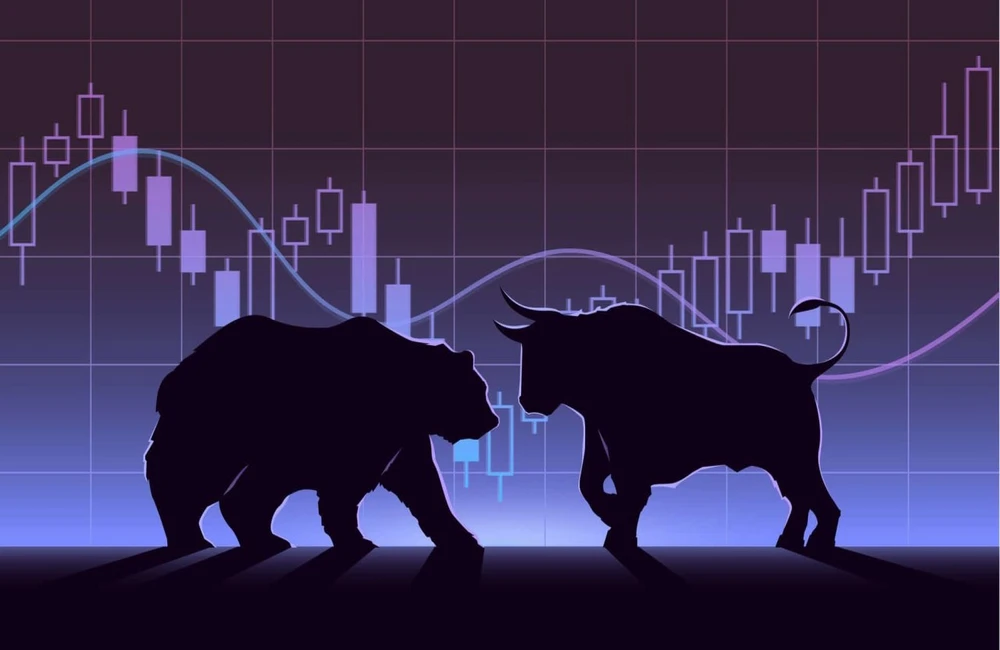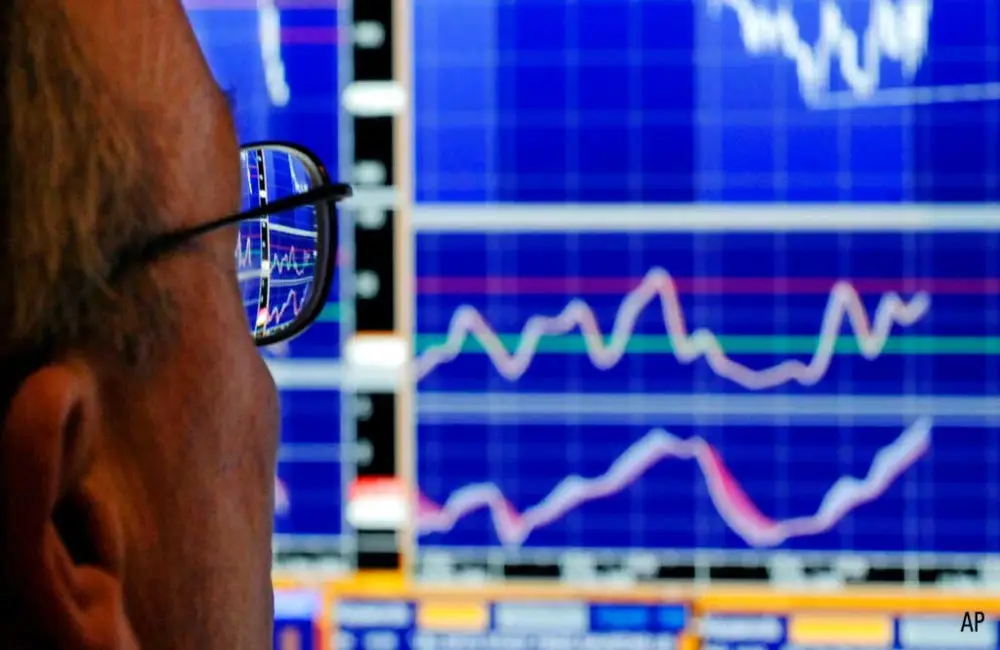On the derivatives market, ASX futures were up 54 points or 0.8 per cent at 7110 at the close of trade on Saturday.
The Nasdaq Composite surged 3.8 percent overseas, its biggest one-day percentage gain since November 2020. The S&P 500 added 2.4 percent and the Dow industrials advanced 1.5 percent. The three indexes closed off peaks hit earlier in the session.
Despite Friday’s advances, all three major indexes ended the week with losses of at least 2 percent. The S&P 500 dropped 2.4 percent and the Nasdaq Composite shed 2.8 percent for their sixth weekly declines in a row. The Dow industrials fell 2.1%.
A reprieve from the brutal spring selloff that has spared virtually no corner of the market was welcome to traders. There were plenty of shocks for the market this week. Inflation was still running hot, disappointing investors, data showed. Cryptocurrencies swooned after a supposed stablecoin collapsed unexpectedly. The S&P 500 on Thursday dipped as much as 19.8 percent from its last high a level that would officially put it into bear market territory, defined as a 20 percent decline from a recent peak and the Dow Jones Industrial Average posted weekly losses for a seventh straight week, its longest streak of losses since July 2001.
“Is the low for the year going to be this week? I don’t think so,” said Andrew Slimmon, senior portfolio manager at Morgan Stanley Investment Management. “I wouldn’t be shocked if we have a deeper growth scare sometime this summer.”
Locally, the S&P/ASX200 index closed on Friday up 134.1 points, or 1.9%, at 7,075.1.
The ASX200 ended the week down 1.8%, marking its fourth week of declines in a row and its lowest point in three months on Thursday.
All 11 of the ASX’s official sectors were up on Friday, with tech surging 7.0 per cent after it suffered an 8.7 per cent thumping on Thursday, the sector’s worst day since March 2020.
“It is looking much more constructive today,” CommSec market analyst Steven Daghlian said.
“The market started the day pretty slowly, and has gradually improved from those levels throughout the day.”
Square Thursday’s worst performer topped the Friday leaderboard, gaining 15% to $114.88. Dorsey’s company is still down 19.6 % on the week, though.
Xero climbed 9.4%, Wisetech Global added 7.3 % and Altium gained 7.1%.
Health care added 3.0 as blood products behemoth CSL rose 3.3 to a three-month peak of $280.20.
Not quite having recovered from Thursday’s losses, the heavyweight mining sector climbed 1.6%.
The big four banks underperformed the rest of the financial sector, which was up 1.4% and led by a 4.5% rise from Macquarie.
In commodity markets, Brent crude oil climbed 4.4% to US$110.49 a barrel. Iron ore dipped 0.2% to US$127.35. Gold was flat at US$1808.90.
Local bonds continued a rally on Friday, with the yield on the Australian 2 Year government bond falling to 2.52% while the 10 Year fell to 3.39%. Investors headed the other way abroad and yields on US Treasury 2 Years creeped up to 2.58% and the 10 Year gained to 2.92%.
The Australian dollar was last quoted buying 69.30 US cents on Saturday. The Wall Street Journal Dollar Index, which measures the US dollar against 16 other currencies, eased to 96.71.
Asia
Chinese stocks finished the week higher, tracking broad gains in other Asian share markets. The Shanghai Composite Index added 1.0%, to 3084.28; the Shenzhen Composite Index firmed 0.5%, to 1931.45; and the ChiNext Price Index climbed 0.3%, to 2358.16.
Economic data from China next week including industrial production and retail sales will be in focus for investors, IG market analyst Yeap Jun Rong said in a note. Such data is expected to show the toll of China’s Covid-19 lockdowns on economic activity, he adds. Bank stocks are higher. Industrial & Commercial Bank of China rose 1.1% and Agricultural Bank of China increased 0.7%.
Europe
European markets added to early gains on Friday on optimism following a buoyant start in Wall Street trading. The pan-European Stoxx Europe 600 climbed 1.9 percent along with the German DAX and added 1.8 percent, while the French CAC 40 was up more than 2 percent.
“Today’s price action has turned out to be fairly orderly, as well as positive to boot, with gains across the board in Europe, as we look to cap off a week of gains,” CMC Markets analyst Michael Hewson says, closing at the highs of the week.” “Today’s gains have been broad-based, with energy, financials, healthcare and consumer goods seeing solid demand.”
London’s FTSE 100 added 2.6%, bouncing back from steep losses earlier this week, with gains in banking and oil stocks, while financials, healthcare and consumer goods remained in demand. Anxiety about whether pandemic-related lockdowns in China were crimping global growth helped balance fears about tight fuel supplies from Russia, the world’s second-largest oil exporter.
BP rose 3.6%, while Shell gained 2.8%. The day’s biggest gainers included Scotland’s Scottish Mortgage Investment Trust, which rose 7.3%, followed by Flutter Entertainment and Compass Group, gaining 5.6% and 5.3%, respectively. The day’s biggest faller was education company Pearson, which closed down 1.5%, followed by Vodafone, down 0.8%, and Avast, down 0.6%.
North America
U.S. stocks ended higher on Friday, after a week of punishing losses across major indexes.
Traders welcomed a respite from the punishing spring selloff that has ensnared practically every corner of the market. This week has seen a number of shocks for the market. Inflation data showed it still running hot, disappointing investors. Cryptocurrencies swooned after a so-called stablecoin suddenly collapsed. The S&P 500 on Thursday was flirting with bear market territory, a level that is 20 percent lower than a recent high, and the Dow Jones Industrial Average logged weekly losses for a seventh straight week, its longest losing streak since July 2001.
The Nasdaq Composite soared 3.8 percent, its biggest one-day gain in percentage terms since November 2020. The S&P 500 added 2.4%, and the Dow industrials advanced 1.5%. All three indexes closed down from highs reached earlier in the day.
The upticks came after a late-session rally on Thursday helped the Nasdaq composite finish with a gain. The risk-on sentiment followed into foreign stock markets overnight. By Friday morning in the US, investors were buying up shares of battered technology companies ahead of the opening bell.
Even Friday’s gains still left all three major indexes ending the week down at least 2%. The S&P 500 dropped 2.4 percent, and the Nasdaq Composite slid 2.8 percent, marking their sixth straight week of declines. The Dow industrials fell 2.1%.
No bottom, traders and investors were not ready to call.
“Is this week the low for the year? I doubt it,” said Andrew Slimmon, senior portfolio manager at Morgan Stanley Investment Management. “I wouldn’t be shocked if we get a deeper growth scare at some point this summer.”
Inflation remains close to a four-decade high as investors face problems not seen in decades. Many traders think that a recession is becoming more likely the more that the Federal Reserve tries to wrestle pricing pressures back under control. Both institutional and individual investors have started to discount the notion that the Fed can pull off a so-called soft landing, where inflation falls but unemployment remains low and the economy continues to expand.
While Mr. Slimmon said he believes more short-term pain awaits stocks, he is optimistic in the longer term, and he said he thinks the market will rebound by the end of the year, pointing to some fairly upbeat earnings reports. More than three-quarters of S&P 500 companies had posted a positive earnings-per-share surprise for the first quarter, consistent with previous quarters, based on FactSet data.
“I spend an awful lot of my life talking to companies and listening to conference calls of companies, and I can assure you that collectively, I don’t feel the weakness out of companies that I’m seeing in the stock market,” Mr. Slimmon said.
On Thursday, Fed Chair Jerome Powell said getting inflation under control might lead to a near-term hit to the economy. He reiterated his belief that additional half-percentage point increases would probably be appropriate at future meetings, but suggested the central bank could take bigger steps if economic data warrant that kind of action. Federal Reserve Bank of Cleveland President Loretta Mester said Friday that a half-percentage-point increase was warranted at the next two meetings.
The inflation report this week provided little respite for investors, especially after data indicated that the price pressures were by and large broad based. Gasoline prices dropped, but prices rose for groceries and dining out, airline travel and other services, spooking investors who had been hoping that inflation had peaked.
That led many to unload riskier investments and pour into assets viewed as safer. Growth and technology stocks, which are usually hurt by higher interest rates, were especially walloped. The risk-off sentiment spread elsewhere, causing sharp drops in cryptocurrencies.
“This week was a pivot in the markets. The question has transformed from whether we can co-exist in an economy with higher rates to [investors] saying: ‘Are we heading to a recession?’,” said Florian Ielpo, the head of macro at Lombard Odier Investment Managers.
On Friday, though, tech stocks were among those that helped lead the rebound. Nvidia rose $15.31, or 9.5 percent, to $177.06, PayPal climbed $4.54, or 6.1 percent, to $78.83 and Netflix gained $13.33, or 7.6 percent, to $187.64. The S&P 500’s information technology sector finished the day up 3.4 percent.
Shares of Twitter dropped $4.36, or 9.7 percent, to $40.72 after Tesla’s chief executive, Elon Musk, said in a tweet that his plan to purchase the social-media company and take it private was “on hold temporarily,” pending information about the number of fake accounts on the social-media platform. Mr. Musk later posted on Twitter that he would go ahead with the acquisition, helping Twitter pare premarket losses of over 20 percent. Tesla’s stock climbed $41.59, or 5.7 percent, to $769.59.
Robinhood bolted $2.13, or 25 percent, to $10.69 after Sam Bankman-Fried, the founder of the cryptocurrency exchange FTX, revealed a 7.6 percent stake in the brokerage. Duolingo soared $22.79, or 34 percent, to $89.77 after the language-learning platform reported a big increase in revenue and monthly active users.
Energy stocks were among the biggest gainers on Friday as the price of oil rose. Brent, the international crude oil benchmark, climbed 3.8 percent to $111.55. Oil prices dipped lower this week, but are still up more than 40 percent since the start of the year.
Bitcoin rose to about $30,000 on Friday, compared with its 5 p.m. ET level of $28,572.24 on Thursday. Elsewhere in the cryptocurrency markets, the beleaguered stablecoin known as TerraUSD continued to tumble, changing hands at 11 cents. TerraUSD deviated from its usual peg to $1 last weekend after a spate of selling of the token. Its sister token Luna has also crashed this week, trading at half a penny, down from more than $60 on Monday.
























